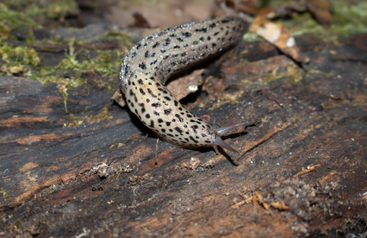 Slimy Little Weirdo While many of our local slugs love to nibble on our baby garden plants, the Leopard Slug, ‘Limax maximus’ has its own diet. They are detritivores, eating decaying plant matter as well as other slugs, making them a gardener’s friend! While the European native Leopard Slug is considered an invasive species to the US, we can’t help but be fascinated by its amazing habits! Consider its mating habits, if you haven’t already. These slugs are not only hermaphroditic, with each partner walking (slime-ing) away from their romantic endeavors pregnant with around 200 fertilized eggs, but they are also thrill seekers. In the evening, once they meet up with a suitable partner (I must admit I don’t know the criteria used by slugs to find partners) they take a romantic stroll together to the ledge of a rock or tree branch where they then lower themselves down on a rope made of their own slime and proceed to have marital relations while dangling in the air. All slugs are gastropods, distantly related to mollusks like squids, mussels, snails, and oysters. The leopard slug is one of the few that still pay homage to their lineage and have a vestigial shell, about the size and shape of a fingernail, located just under their skin. If you are ever in a slug caressing mood, you can actually feel the hidden shell by giving the slug a gentle massage. Also, they are edible. Janet Douberly is a slug masseuse at Downtown Greens. This article was first published in the January 2024 edition of Front Porch Magazine. To view the full publication visit www.frontporchfredericksburg.com
1 Comment
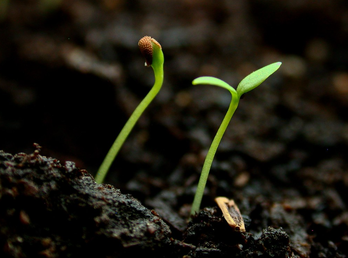 Growing from Seeds Flower and vegetable gardening are great hobbies. Not only do they provide you with beauty and fresh food, but it’s a great way to get outdoors and connect with nature. However, as any gardener can attest to, it can become an expensive hobby. One way to mitigate costs is to start flower and vegetable plants from seeds. Seed starting might sound intimidating, but with a few materials or sometimes just seeds, you can start saving money and starting growing your own plants! There are several ways to start seeds. The easiest way for a beginner is to choose seeds that can be direct sown. Direct sowing seeds means simply placing the seeds in the ground once the chance of a hard frost has passed. To ensure that a plant or multiple plants come up, it’s best to place two to three times the number of seeds for each desired plant. For example, if you want two zucchini plants, place 2-3 seeds per plant location. Then once the seed germinate and become seedlings, you can choose the most robust looking seedling and remove the others. Some popular vegetables that can be direct sown are: zucchini, cucumbers, carrots, beets, and many herbs. Zinnias, wild bergamot, mountain mint are examples of flowers that can be direct sown. Another easy way to start seeds are native flower seeds that need cold stratification. Cold stratification means that the seeds need cold and moist in order to germinate. This can be accomplished in a couple of ways. One is to plant the seeds in the fall and hope for a cold and wet winter (some native plants, such as Jack in the Pulpit, require two cold and wet seasons). If you waited too long, you can also create the cold stratification conditions by using a medium, such as damp peat moss, and place the seeds in the refrigerator for the recommended time, usually 30-60 days, followed by sowing the seeds outdoors. A third common way to germinate seeds is by starting them indoors with enough lead time to allow the plants to germinate, grow, and then harden off, which means to allow the young plants time to get acclimatized to being outdoors. The items you will need are: seeds, seed starting soil, a container with a plastic dome and drainage hole, this does not need to be a special seed starting container, food clamshells work great, a light source, either a full spectrum fluorescent lights or a very sunny windowsill, and potting soil and containers to transplant seedlings. By reading the back of the seed packet for the desired plant, it will tell you how long it will take to start seeds indoors. For the Fredericksburg area, the last frost usually occurs around the middle of April. The key with growing seeds indoors is to monitor them daily to ensure that they are getting the correct amount of water, and to watch their growth. Starting seeds is a rewarding and economical way to add plants to your flower or vegetable garden. Also, if you end up not liking a particular flower or vegetable, then you haven’t invested a lot of money in it and can try something else the following year. Christie Hoerneman is President of the Board of Directors at Downtown Greens. This article was first published in the January 2024 edition of Front Porch Magazine. To view the full publication visit www.frontporchfredericksburg.com 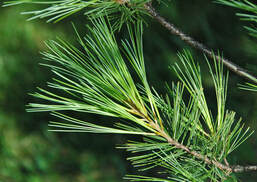 Evergreen Scene It’s a pine! It’s a cedar! It’s a….evergreen of sorts. Now that our deciduous trees have given up the ghost until spring, let’s take this opportunity to learn about some of the towering stars of the current show, evergreen trees. Here in Virginia we can find pines, cedar, spruce, yew, and even redwoods. Let’s take a look at how we can easily tell the difference between these sometimes pungent, sometimes prickly trees. Pines like to give their needles buddies. If the tree has needles in groups of two, three, or five you can bet it’s a pine. If you pluck a needle and it doesn’t readily roll between your fingers, it’s probably a fir. If the needles are long and in groups of 3, that’s our native loblolly. Five needles gives you a white pine and two needles that are trying to entwine with each other tells you it’s our namesake, the Virginia Pine. When it comes to cedar we have a juniper. Our native Eastern Redcedar is actually in the juniper family which is why you may think of gin when you smell the crushed small blue berries growing with its scaly leaves. Virginia’s endangered northern flying squirrels are definitely familiar with our native Red Spruce, also known as a Yellow Spruce just to keep things confusing. Though they probably don’t need to stop and check for the 4-sided, short, yellowish-green needles on pegs. Janet Douberly wrote this article to help her learn how to ID conifers and hopes it helps you too. This article was first published in the January 2024 edition of Front Porch Magazine. To view the full publication visit www.frontporchfredericksburg.com 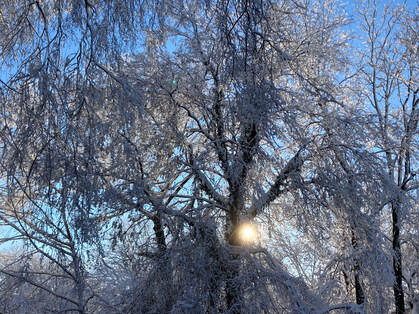 There is a Season Sometimes in our very busy world, it is easy to forget that we came from nature and we are still a part of nature. Underneath our sweaters and Starbucks beats a heart that longs to follow nature’s rhythms. Those of us who garden and spend time in nature, see these rhythms play out year after year and even we can get caught up in our human-made mantra of “Go! Go! Go!”. Afterall, bosses have deadlines for us, Target has sales for us, plane seats have tickets for us, how could we possibly deny the pull of the world we created? But every once in a while, if you’re really lucky, you can answer winter’s call to slow down, to breathe, to reassess, and to make plans. Gardeners in our area are already doing it to some level. Our beloved beds are sleeping and waiting (and still growing kale?!?!) while we sit inside dreaming of and planning next year’s garden. Picking our plants, ordering our seeds, and fantasizing about little green shoots popping through the pungent and barely warmed soil. Of course, we here at Downtown Greens are following this rhythm. This past year was another doozy in a long line of doozies. But now nature and our gardens have slowed down to slumber. And while we aren’t slumbering, we are taking a moment to create plans for our plans. The 56 acres is protected and paid for. The mad race to raise the money and jump through paperwork hoops is over. Step 1, the very biggest step, is complete. And now, in the deep of winter, we are cuddled up (metaphorically, nothing weird) making plans, writing out details, and preparing for the next season. We are always aware and amazed by the fact that the plans being made now wouldn’t be feasible without the support of the community we serve. We are so excited for the next season and hope you will join us and support us in the seasons to come. May your winter be restful. Janet Douberly is Media Manager and Garden Advisor at Downtown Greens. This article was first published in the January 2024 edition of Front Porch Magazine. To view the full publication visit www.frontporchfredericksburg.com 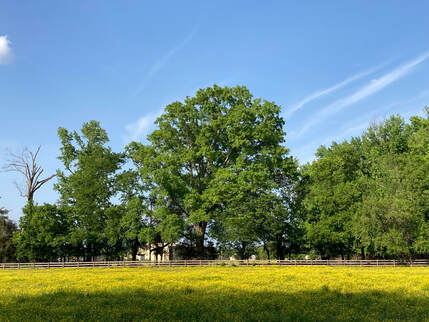 Protected in Perpetuity Many of you have been following our journey to protect 56 acres of land located on Belman Road in the Fredericksburg Industrial Park. We are happy to report that we have successfully recorded an easement with the Virginia Outdoors Foundation that protects our 56 acres of green open space land for current and future generations! With our Upper and Lower Gardens, that brings the total of protected greenspace in the city to 58.8 acres! We are grateful for all the support that has brought us to this juncture. It has taken thousands of hours of staff, Board and volunteer work to get us here. It took City Council amending their Comprehensive Plan to incorporate the change of the land status for us to be able to get an easement. And it literally took a village, a village of 520 supporters during a four month campaign in 2021 to provide the necessary funds for us to be able to purchase the property. The Belman Road property–wetlands, woodlands, and agricultural land, holds the promise of a diverse open space for all to enjoy. And it holds the promise of educational opportunities for all age groups as well. We are looking forward to working with schools in the area and the University of Mary Washington so that they can use the property as an outdoor classroom for nature based learning. If you have not had a chance to see what this property entails, we urge you to take one of our New Land Walkarounds. Get your group together and join us for a tour! You can find upcoming dates for the walkarounds at downtowngreens.org and on our social media. What’s next for the property? We are already at work! We have planted a fruit tree forest of 810 trees on several acres. We recently held a mulching party to help them continue their growth, and will be putting in fencing to keep the deer from munching on them. The fruit tree forest is a continuation of the successful open-access garden and green space for all to enjoy with education and community mindedness at its core. Another opportunity for the land is an agricultural training center that will inspire, educate and equip the next generation of farmers. This would include the mechanics of ‘hands in the dirt’ farming as well as the critical components of managing a successful farm including marketing, small engine repair, food safety training, irrigation and hydroponics, digital technologies and more. Bringing all these components together in a thoughtful way for the new property will take careful planning, collaboration with community partners, land cultivation and resources. There is much work ahead for us to turn this opportunity into reality, something the entire city can be proud of. With your support, we look forward to the challenge. Speaking of opportunities, there are plenty of opportunities to volunteer with us both at the Belman Road property and the upper and lower gardens downtown, the monthly food distribution in cooperation with the Fredericksburg Regional Food Bank, or volunteering to help with our Free Fridge program. If you are interested in helping out, please go to downtowngreens.org or follow us on social media to see upcoming projects. Jim Schepmoes is Executive Director of Downtown Greens. This article was originally published in the May 2023 edition of Front Porch Magazine. Read the full publication by using the link below. 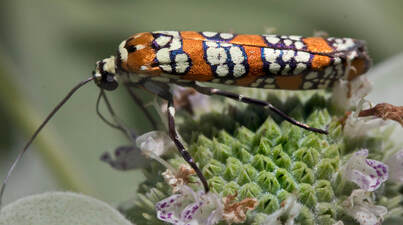 Moth of Heaven If you follow nature news you have probably already heard of the dreaded Spotted Lanternfly and its host plant, the deplorable Tree of Heaven a.k.a Ailanthus Tree. Knowing how awful these invasive trees can be, you will probably be cheered to learn about a pollinator taking advantage of this growing opportunity. Native to South Florida down to Costa Rica, the Ailanthus Webworm Moth, or Atteva aurea, feeds and lives in its natural host plant, the native paradise tree. When the Asian Tree of Heaven was introduced as a good tree for urban landscaping in 1784 (big sigh) the Ailanthus webworm moth found this invasive tree to be just as yummy and useful as its native host tree and has since been found more northward than in the past. While Ailanthus Webworm Moths do die off in our cold winters, they quickly move back once spring hits and are considered a useful pollinator in our gardens! In flight this moth resembles a wasp and when not in flight can look very similar to a beetle or true bug. As adults, they feed on the pollen and nectar of our beautiful blooms. Before striking out to pollinate the world, these little diurnal moths spend almost all of their life-cycles in the loose webs that enclose the leaves of the ailanthus tree, which allows the caterpillars to feed without leaving the safety of the web and stay until adulthood. Janet Douberly loves the Ailanthus Webworm Moths at Downtown Greens. This article was originally published in the May 2023 edition of Front Porch Magazine. Read the full publication by using the link below. 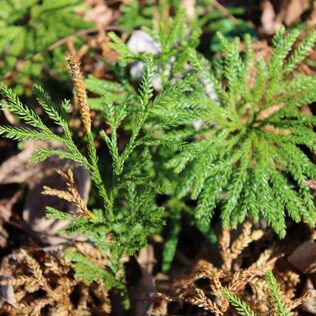 A what now? It's a tree! It's a moss! No, it's Tree Clubmoss....which is actually a fern ally. Confused yet? Let's break it down! Fern allies are a diverse group of seedless (reproduces through spores) plants that are not true ferns. Essentially, these little dudes are plants that, like ferns, spread by producing and releasing spores instead of seeds. But they aren't ferns. Or trees. Or moss. This perennial evergreen, aka 'Dendrolycopodium obscurum', stays under a foot tall and creeps along the ground, usually in forest areas. Paired with our native ferns this gives us some excellent greenery in the middle of winter! In the fall, this plant releases its spores from green, upright, tubular growths, or "clubs"! Sadly, due to...well...humans, this species of plant is considered endangered in many areas. So if you see some growing, leave it be! Fossils tell us that ancient tree clubmosses grew as much as 130 feet tall and 5 feet around long before the dinosaurs reigned. The spores released from this tiny spreader are so oily and water-resistant they have been used in many ways including powders to soothe chafed skin and protect wounds. Large quantities of the spores were also once used to coat pills to keep them from sticking together. In the early days of photography, the spores were used as flash powder. When ignited, the dry, flammable spores would explode in a brilliant flash of light. Janet Douberly is a brilliant flash of light at Downtown Greens. This article was originally published in the November 2023 edition of Front Porch Magazine. www.frontporchfredericksbueg.com  There is a Season In the over 27 years Downtown Greens has been in existence, it has seen a LOT of changes. Not only within its gardens but also here in town. Homes have been built, dams have been brought down (with only some delay). Our population has grown, we’ve elected new mayors and city officials, new folks have become neighbors, and the river keeps flowing. A goose has become a star, the otters have come back, and our sweet river foxes have had many kits. But one thing that hasn’t changed in Fredericksburg in the past 27 years is its heart and overwhelming sense of welcome. The same could be said about Downtown Greens. So much has changed and yet our roots stay constant. This organization, which started as slightly less than 2 acres, can now boast a whopping 58.8 acres of greenspace being conserved and utilized for and by our community. We’ve had Downhome Balls, Fork It Over Festivals, Downtown Runarounds, block parties, free yard sales, concerts, and Backyard Soirées. We remember times when hand sanitizer meant rinsing the mud off with a garden hose. We struggled along with our community during covid and found ways to support each other until we came through on the other side. Laura Shepherd and Lisa Beaver carved Downtown Greens out of the clay loam, growing flowers, food, and friendships. Sarah Perry came with a sharp mind and an eagerness to watch us grow and took on the mantle of running and greatly expanding this once small community greenspace. And now we enter the next phase. Please welcome our new Executive Director and all round swell guy, Jim Schepmoes! Jim, a native Virginian, has over 20 years of experience working at nonprofits dedicated to preservation and to helping disadvantaged populations. He has a bachelor’s degree from Virginia Commonwealth University and a master's degree from Kent State University. He and his wife, Rita, live on a small farm in King George County with Holly, their barky Beagle and numerous Wyandotte chickens. When asked what about joining the DTG team he was most excited for, Jim said "I am most excited about the expansion of educational opportunities at all levels that the new campus will provide to the community. We will be able to connect many more people with experiential greenspace education." And, of course, what DTG interview would be complete without some lightning round questions! Favorite flower: Cone flower Favorite vegetable: Squash Favorite insect: Dragonfly Favorite Virginia native plant: Cone flower Favorite movie: Citizen Kane In addition to having great taste in flowers and vegetables, Jim brings to the table years of experience, a dedication to the mission, and a fresh take that will help Downtown Greens grow and provide even more opportunities for our community! Please join the staff and Board of Directors in showing Jim a warm Fredericksburg welcome! We look forward to this community standing together as it has done all these years to support our mission, celebrate the gains, and continue to enjoy the greenspaces made possible by our combined efforts. With Jim’s guidance we cannot wait to see how much more we can do and how much further we can grow in the next 27 years. Janet Douberly is Media Manager at Downtown Greens.  There is a Season In the over 27 years Downtown Greens has been in existence, it has seen a LOT of changes. Not only within its gardens but also here in town. Homes have been built, dams have been brought down (with only some delay). Our population has grown, we’ve elected new mayors and city officials, new folks have become neighbors, and the river keeps flowing. A goose has become a star, the otters have come back, and our sweet river foxes have had many kits. But one thing that hasn’t changed in Fredericksburg in the past 27 years is its heart and overwhelming sense of welcome. The same could be said about Downtown Greens. So much has changed and yet our roots stay constant. This organization, which started as slightly less than 2 acres, can now boast a whopping 58.8 acres of greenspace being conserved and utilized for and by our community. We’ve had Downhome Balls, Fork It Over Festivals, Downtown Runarounds, block parties, free yard sales, concerts, and Backyard Soirées. We remember times when hand sanitizer meant rinsing the mud off with a garden hose. We struggled along with our community during covid and found ways to support each other until we came through on the other side. Laura Shepherd and Lisa Beaver carved Downtown Greens out of the clay loam, growing flowers, food, and friendships. Sarah Perry came with a sharp mind and an eagerness to watch us grow and took on the mantle of running and greatly expanding this once small community greenspace. And now we enter the next phase. Please welcome our new Executive Director and all round swell guy, Jim Schepmoes! Jim, a native Virginian, has over 20 years of experience working at nonprofits dedicated to preservation and to helping disadvantaged populations. He has a bachelor’s degree from Virginia Commonwealth University and a master's degree from Kent State University. He and his wife, Rita, live on a small farm in King George County with Holly, their barky Beagle and numerous Wyandotte chickens. When asked what about joining the DTG team he was most excited for, Jim said "I am most excited about the expansion of educational opportunities at all levels that the new campus will provide to the community. We will be able to connect many more people with experiential greenspace education." And, of course, what DTG interview would be complete without some lightning round questions! Favorite flower: Cone flower Favorite vegetable: Squash Favorite insect: Dragonfly Favorite Virginia native plant: Cone flower Favorite movie: Citizen Kane In addition to having great taste in flowers and vegetables, Jim brings to the table years of experience, a dedication to the mission, and a fresh take that will help Downtown Greens grow and provide even more opportunities for our community! Please join the staff and Board of Directors in showing Jim a warm Fredericksburg welcome! We look forward to this community standing together as it has done all these years to support our mission, celebrate the gains, and continue to enjoy the greenspaces made possible by our combined efforts. With Jim’s guidance we cannot wait to see how much more we can do and how much further we can grow in the next 27 years. Janet Douberly is Media Manager at Downtown Greens. 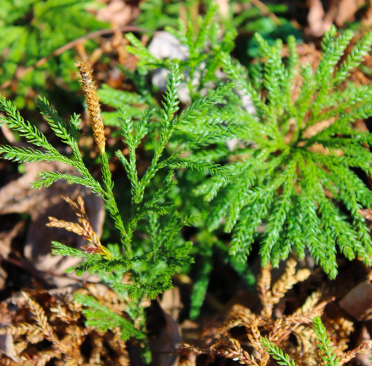 A what now? It's a tree! It's a moss! No, it's Tree Clubmoss....which is actually a fern ally. Confused yet? Let's break it down! Fern allies are a diverse group of seedless (reproduces through spores) plants that are not true ferns. Essentially, these little dudes are plants that, like ferns, spread by producing and releasing spores instead of seeds. But they aren't ferns. Or trees. Or moss. This perennial evergreen, aka 'Dendrolycopodium obscurum', stays under a foot tall and creeps along the ground, usually in forest areas. Paired with our native ferns this gives us some excellent greenery in the middle of winter! In the fall, this plant releases its spores from green, upright, tubular growths, or "clubs"! Sadly, due to...well...humans, this species of plant is considered endangered in many areas. So if you see some growing, leave it be! Fossils tell us that ancient tree clubmosses grew as much as 130 feet tall and 5 feet around long before the dinosaurs reigned. The spores released from this tiny spreader are so oily and water-resistant they have been used in many ways including powders to soothe chafed skin and protect wounds. Large quantities of the spores were also once used to coat pills to keep them from sticking together. In the early days of photography, the spores were used as flash powder. When ignited, the dry, flammable spores would explode in a brilliant flash of light. Janet Douberly is a brilliant flash of light at Downtown Greens. |
AuthorWrite something about yourself. No need to be fancy, just an overview. Archives
February 2024
Categories |
 RSS Feed
RSS Feed